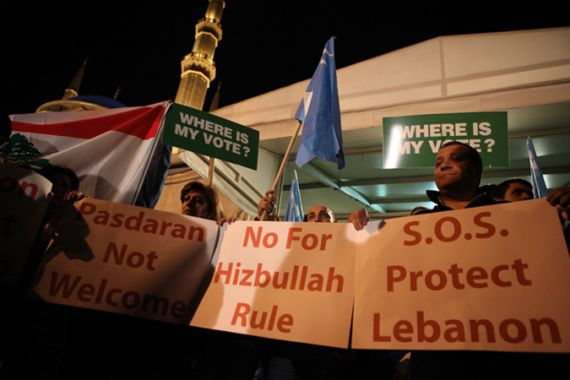Lebanon convulses on ‘Day of Rage’
View slide show of protests by Sunni backers of Saad Hariri, after US-backed March 14 coalition lost majority status.

The Arab world is on fire. After the Tunisian uprising ousted that country’s Western-backed dictator of 23 years earlier this month, unprecedented protests inspired by events in Tunisia have been taking place in a number of Arab countries. Most notable has been Egypt, where, since Tuesday, tens of thousands of Egyptians have been taking to the streets demanding an end to their Western-backed dictator’s 30-year rule.
Parts of Lebanon were also ablaze on Tuesday, albeit they were fires a different kind. Instead of a nationwide movement calling for change and an end to unjust leadership, protests in Lebanon only fanned the flames of sectarian tensions in the deeply divided nation.
What Lebanon shares with the rest of the region is that allies of the West inside the country are quickly losing their influence. In recent weeks, the US-backed March 14 coalition lost its majority status in Lebanon’s government. Two weeks ago, Sunni leader and then prime minister Saad Hariri’s government was collapsed by the Syria and Iran-backed March 8 coalition, which includes the Shia resistance and political movement Hezbollah.
After the government’s collapse, Druze leader and former March 14 ally Walid Jumblatt sided with March 8, giving the former opposition coalition a majority of seats in parliament. The move enabled March 8 to vote its candidate Najib Miqati into the premiership. According to Lebanon’s complex sectarian system of government, the prime minister must be a Sunni.
The selection of Miqati outraged many of Lebanon’s Sunnis, who have largely been loyal followers of the Hariri family. In response to the failed attempt to select him as prime minister again, thousands of Hariri’s supporters around the country took to the streets on Tuesday in protest.
Starting on Monday evening, supporters of Saad Hariri gathered outside the grave of his father, former prime minister Rafiq Hariri, who was assassinated in 2005. On the following day, demonstrations spread to other mostly Sunni areas of the country in what organizers labeled a “Day of Rage”.
The day’s demonstrations began early on Tuesday in the northern city of Tripoli, where things quickly turned violent. Hariri supporters burned pictures of Miqati, attacked Lebanese soldiers, and menaced both local and foreign journalists. A news van belonging to Al Jazeera was set on fire and completely destroyed. In other areas, Hariri supporters blocked roads with burning tires and other debris, bringing much of the country to a standstill.
In central Beirut’s working-class Tariq al-Jadide neighborhood, a stronghold for Hariri, clashes lasted throughout the day between protestors and the Lebanese army. Journalists were chased away with stones, while the army put out fires that had shut down one of Beirut’s main junctions. Clashes continued into the night as the army advanced into Tariq al-Jadide and reportedly detained a number of armed men.
The demonstrations brought back fears of May 2008, when the worst armed clashes since Lebanon’s civil war ended in 1990 broke out between March 8 and March 14 groups around Lebanon. At this point it’s uncertain whether or not Tuesday’s demonstrations will serve as a spark to inflame an already tense situation in the country. However, with the US already calling the new Lebanese government “Hezbollah controlled” and its Lebanese allies intent on regaining power, any kind of political stability in Lebanon remains a long way away.
The slide show above documents demonstrations in the Lebanese capital over a 24-hour period beginning on Monday evening.